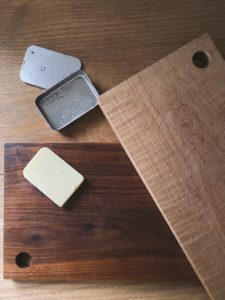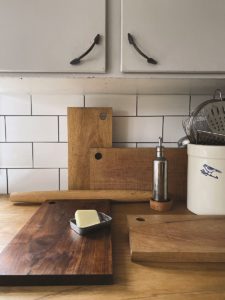Though wood craftspeople often finish their handmade work with oils made from plants or seeds — linseed or tung — mineral oil is often recommended for ordinary people to use to treat their wooden cutting boards and countertops.

Maybe that’s because it is so highly refined, it has a long shelf life. And, in liquid form, it’s easy to work with. Mineral oil will condition wood and repel water. But even through it’s considered food-safe, it is a petroleum product, derived from refining crude oil to make gasoline.
That unsettled me and got me thinking about how to make my own cutting board and butcher block treatments from other sources. I chose beeswax and walnut and coconut oils. The beeswax repels water, while the oils nourish the wood surface. Obviously, if you have nut allergies, you’ll need to choose oils you can work with.
Melting these three ingredients together, I experimented with ratios to produce conditioners with a range of consistencies, from a buttery paste to a waxier, near-solid product. Use more oils to create a paste that can be stored in a jar. Use more beeswax and pour the formula into a mold (any small can, like an Altoids tin, will work) to make bars similar to those used for skateboard or surfboard wax.
I’ve been using this formula for years to replenish and condition my countertop, cutting boards, and wooden spoons. It also works wonders on leather goods to restore luster and shine.
Here’s the spa day part. To use your wood conditioner, begin by thoroughly cleaning the wood. A halved lemon and salt make an excellent natural scrub for surfaces. Then, allow plenty of time for the wood to dry before applying wax. Rub on a small amount with clean hands and thoroughly work it into the surface. Buff with a lint-free cloth and reapply as needed.
Natural Butcher Block Wax

Ingredients and tools for a 2-oz. bar
¾ oz. beeswax
¾ oz. walnut oil
½ oz. unrefined coconut oil
Heatproof 2-cup glass measuring cup
Heavy pot, large enough to hold the measuring cup
Stirring stick
Metal mold (a small empty can or mint tin)
Scale
- Weigh out the beeswax and oils into your measuring cup. This recipe makes a bar, but if you prefer a paste-like formula, simply increase the walnut and coconut oils by up to about half again as much as the bar recipe calls for.
- Create a double boiler of sorts, placing the measuring cup in the pot, and filling the pot with enough water to reach above the level of your ingredients — but use caution to not splash or spill water into the oil-wax mixture.
- Over low to medium-low heat, slowly melt oils and wax together until fully combined, stirring gently.
- Carefully pour oil mixture into the tin (or, if you are making a paste, you can pour it into a heatproof glass jar).
- After the wax is completely cooled, unmold your bar (or cap your jar of paste with a lid).
- Store out of heat and direct sunlight and use within a year.



